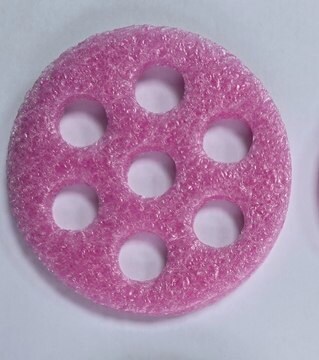Regenerated cellulose membranes are typically compatible with acids and alcohols. Organic solvent compatibility varies from compound to compound. However, the solvent concentration, temperature, and exposure time are factors to be considered. Please see the table below to review the general membrane compatibility with various solvents.
D9652
Dialysis tubing cellulose membrane
avg. flat width 33 mm (1.3 in.)
Synonyme(s) :
Cellulose Dialysis Tubing, Cellulose Membrane, Dialysis Membrane
Sélectionner une taille de conditionnement
160.00 CHF
Date d'expédition estimée le23 mars 2025
Sélectionner une taille de conditionnement
About This Item
160.00 CHF
Date d'expédition estimée le23 mars 2025
Produits recommandés
Diam. moyen
21 mm , when full
Largeur moy. à plat
33 mm (1.3 in.)
Capacité
~110 mL/ft
Vous recherchez des produits similaires ? Visite Guide de comparaison des produits
Description générale
Conditionnement
Qualité
Notes préparatoires
Code de la classe de stockage
13 - Non Combustible Solids
Classe de danger pour l'eau (WGK)
WGK 3
Point d'éclair (°F)
Not applicable
Point d'éclair (°C)
Not applicable
Faites votre choix parmi les versions les plus récentes :
Certificats d'analyse (COA)
Désolés, nous n'avons pas de COA pour ce produit disponible en ligne pour le moment.
Si vous avez besoin d'assistance, veuillez contacter Service Clients
Déjà en possession de ce produit ?
Retrouvez la documentation relative aux produits que vous avez récemment achetés dans la Bibliothèque de documents.
Les clients ont également consulté
Contenu apparenté
Dialysis Tubing
-
Which organic solvents can be used with these membranes?
1 answer -
how do I prepare the tubings before usage?
1 answer-
Instructions have been provided in the 'Preparation Note' in the 'DESCRIPTION' section.
-Wash the tubing in running water for 3-4 hours to remove glycerol included as a humectant.
-Treat the tubing with a 0.3% (w/v) solution of sodium sulfide at 80°C for 1 minute to remove sulfur compounds.
-Wash with hot water (60°C) for 2 minutes, followed by acidification with a 0.2% (v/v) solution of sulfuric acid, then rinse with hot water to remove the acid.
This tubing will retain most proteins of molecular weight 12,000 or greater.Helpful?
-
Active Filters
Notre équipe de scientifiques dispose d'une expérience dans tous les secteurs de la recherche, notamment en sciences de la vie, science des matériaux, synthèse chimique, chromatographie, analyse et dans de nombreux autres domaines..
Contacter notre Service technique






